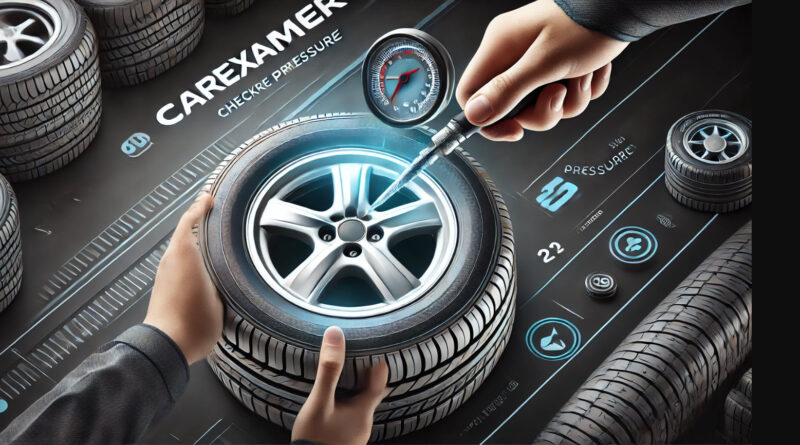How to Check Your Tyre Pressure and Why It’s Important
In this article, we’ll walk you through how to check your tyre pressure and explain why it’s so important. Maintaining the correct tyre pressure is one of the simplest yet most crucial aspects of vehicle maintenance. Not only does it ensure your car runs smoothly, but it also plays a vital role in your safety on the road. Underinflated or overinflated tyres can lead to a host of problems, including poor fuel efficiency, uneven tyre wear, and even dangerous blowouts.
Why is Tyre Pressure Important?
Safety
- Proper tyre pressure is essential for maintaining control of your vehicle. Underinflated tyres can lead generally to outer edge wear on both sides of tyre and to reduced grip, especially in wet or icy conditions, increasing the risk of skidding or losing control. Overinflated tyres generally will result tyre wear on the middle of the tyre and on the other hand, can cause blowouts, which can be catastrophic, especially at high speeds.
Fuel Efficiency
- Tyres that are not properly inflated can cause your vehicle to work harder, leading to increased fuel consumption. Keeping your tyres at the recommended pressure can improve fuel efficiency, saving you money at the pump.
Tyre Longevity
- Correct tyre pressure ensures even wear across the tyre’s surface. Underinflated tyres tend to wear out on the edges, while overinflated tyres wear more in the center. Both conditions can shorten the lifespan of your tyres, leading to the need for premature replacement.
Environmental Impact
- When your tyres are properly inflated, your car uses less fuel and produces fewer emissions.
How to Check Your Tyre Pressure
1.Find the Recommended Tyre Pressure
- The recommended tyre pressure for your vehicle can usually be found in the owner’s manual or on a sticker inside the driver’s door or fuel cap. It’s important to note that the recommended pressure is different for the front and rear tyres.
2. Use a Reliable Tyre Pressure Gauge
- To accurately check your tyre pressure, you’ll need a reliable tyre pressure gauge. Digital gauges are often more accurate than analog ones and are easy to use. You can purchase a tyre pressure gauge at most auto parts stores.
3. Check the Tyres When They’re Cold
- Tyre pressure should be checked when the tyres are cold, meaning the car hasn’t been driven for at least a few hours. Driving heats up the tyres, which can give a false reading due to the expansion of air inside the tyres.
4. Remove the Valve Cap
- Start by removing the valve cap from the tyre. Keep the cap in a safe place while you check the pressure.
5. Attach the Gauge to the Valve Stem
- Press the tyre pressure gauge firmly onto the valve stem. You should hear a brief hiss of air as the gauge takes a reading. If you hear continuous hissing, you may not have the gauge properly aligned, so try again.
6. Read the Pressure
- Once the gauge is attached correctly, it will display the tyre’s pressure. Compare this reading to the recommended pressure for your vehicle.
7. Adjust the Pressure If Necessary
- If the tyre pressure is too low, use an air compressor to add air until you reach the recommended level. If the pressure is too high, release some air by pressing down on the valve stem until the correct pressure is achieved.
8. Replace the Valve Cap
- After checking and adjusting the pressure, be sure to replace the valve cap securely.
9. Repeat for All Tyres
- Don’t forget to check all four tyres, and remember that the spare tyre should also be checked periodically.
When to Check Your Tyre Pressure
- Monthly Checks: Tyres naturally lose air over time, so it’s a good idea to check the pressure at least once a month.
- Before Long Trips: Check your tyre pressure before embarking on a long journey, especially if you’ll be carrying extra weight, such as passengers or luggage.
- When the Temperature Changes: Tyre pressure can fluctuate with the temperature. For every 10°F change in temperature, your tyre’s pressure can change by about 1 PSI. This makes it particularly important to check your tyres during seasonal changes.
Keeping your tyres properly inflated is a simple task that can have a significant impact on your vehicle’s performance, safety, and longevity. Regularly checking your tyre pressure not only helps you avoid costly repairs and replacements but also ensures that you and your passengers are safe on the road. Make tyre pressure checks a regular part of your vehicle maintenance routine, and you’ll enjoy a smoother, more efficient ride.
Buying a used VW. Buying used vauxhall, BMW, Jaguar, Ford, Volvo, Range rover, Bentley, Aston Martin, Porsche, Ferrari, Lamborghini, Maserati, Hyundai, Tesla, Honda, Pagani

